|
|
 |
|
Calanoida ( Order ) |
|
|
|
Clausocalanoidea ( Superfamily ) |
|
|
|
Euchaetidae ( Family ) |
|
|
|
Paraeuchaeta ( Genus ) |
|
|
| |
Paraeuchaeta austrina (Giesbrecht, 1902) (F,M) | |
| | | | | | | Syn.: | Euchaeta austrina Giesbrecht, 1902 (p.22, figs.F,M); Wolfenden, 1911 (p.296); Hopkins & Torres, 1988 (tab.1); Fontaine, 1988 (p.46, figs.F);
? E. austrina : Vervoort, 1957 (p.78, figs.M, Rem.) | | | | Ref.: | | | Senô & al., 1963 a (p.8, figs.F); Bradford, 1981 (p.401: Table 5): Bradford & al., 1983 (p.20); Park, 1994 (p.321); 1995 (p.90, Rem.) | 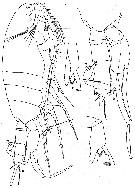 issued from : W. Vervoort in B.A.N.Z. Antarctic Reseach Expedition, Reports - Ser. B, Vol. III, 1957 [Fig.55]. With doubt. Male (from 66°11'S, 65°10'E): a, habitus (lateral); b, posterior part cephalothorax and urosome (lateral); c-d, terminal portions of left P5.
|
 issued from : W. Vervoort in B.A.N.Z. Antarctic Reseach Expedition, Reports - Ser. B, Vol. III, 1957 [Fig.56]. With doubt. Male: a, posterior part cephalothorax and genital somite (dorsal); b, forehead (lateral).
|
 issued from : J.M. Bradford in N. Z. Jl Mar. Freshw. Res., 1981, 15. [p.401, Table 5 (part.)]. Female & Male (from Giesbrecht, 1902): Distinguishing features of species of Paraeuchaeta closely related to P. antarctica (* for code see p.393, Fig.2 in P. erebi).
|
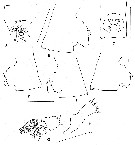 issued from M. Fontaine in Biol. Antarctic Seas XIX, Antact. Res. Ser., 1988, 47. [p.47, Fig.16]. As Euchaeta austrina. Female (from Ross Sea): A, rostrum; B-F, genital segment (B, sta. 2086, right lateral; C, sta. 2089, ventral; D, sta. 2086, left lateral; E, sta. 2086, ventrolateral; F, sta. 1077, right lateral); G, Md (mandibular palp); H, Md (gnathobase). Nota: A2 as in but with no seta discernible on exopod segment 2. mxp bearing a minute ''flagellum'' or spinule on several of the large curved terminal endopodal setae.
|
 issued from M. Fontaine in Biol. Antarctic Seas XIX, Antact. Res. Ser., 1988, 47. [p.48, Fig.17]. As Euchaeta austrina. Female: A-C, Mx1; D, Mx2; E, P1; F, P2. Scale bars: 0.25 mm each. P. antractica). Exopod of P1: Aa ± 4/5 AB; Bb > BC; Cc ± 5/4 BC. Exopod of P2: Aa ± 4/3 AB; Bb ± 1/2 BC; Cc ± 2/3 CD.
|
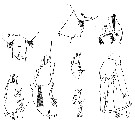 issued from : W. Giesbrecht in Copepoden. Res. voyage du S. Y. Belgica. Rapports scientifiques, Zoologie, 1902. [Taf. III, Figs.9-16]. As Euchaeta austrina. Female (from S Peter Ist Island): 9, last thoracic segment and genital segment (ventral); 10, idem (lateral); 11, exopod of P1; 13, exopodite 3 of P3. Male: 12, exopod of P1; 14, exopodite 3 of P2; 15, P5 (anterior); 16, distal part of left P5.
|
 Paraeuchaeta austrina Female: Paraeuchaeta austrina Female:
1 - See key to species Groups and independent species of Paraeuchaeta (p.30).
2 - An endopodal seta of Mx2 armed with long spinules in addition to dense rows of small spinules (Fig.17 D in Fontaine, 1988).
3 - Ventrally, genital field about symmetrical (Fig.16 C in Fontaine, 1988).
| | | | | Compl. Ref.: | | | Sewell, 1948 (p.574); Razouls & al., 2000 (p.343, tab. 2, 5, Appendix); Park & Ferrari, 2009 (p.143, Table 3, 8, Appendix 1, biogeography) | | | | NZ: | 1 | | |
|
Distribution map of Paraeuchaeta austrina by geographical zones
|
| | | | | |  issued from : W. Vervoort in B.A.N.Z. Antarctic Reseach Expedition, Reports - Ser. B, Vol. III, 1957 [Fig.57]. As Euchaeta austrina male. issued from : W. Vervoort in B.A.N.Z. Antarctic Reseach Expedition, Reports - Ser. B, Vol. III, 1957 [Fig.57]. As Euchaeta austrina male.
Chart showing the geographical distribution (white circle) in the seas surrounding the Antarctic continent.
Nota: In this chart the area frequented by whaling vessels has been hatched. The Antarctic circle (66°.5 S) has been drawn as a broken line. The numbers I to VI refer to the sectors into which the Antarctic seas are divided according to Mackintosh (1942) (after Vervoort, 1951). |
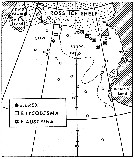 issued from M. Fontaine in Biol. Antarctic Seas XIX, Antact. Res. Ser., 1988, 47. [p.43, Fig.13]. issued from M. Fontaine in Biol. Antarctic Seas XIX, Antact. Res. Ser., 1988, 47. [p.43, Fig.13].
Occurrence of P. austrina.
Open circles show stations where no adults were found. RSSW = Ross Sea Shelf Water; CDW = Circumpolar Deep Water. |
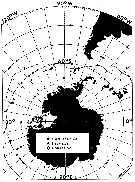 issued from M. Fontaine in Biol. Antarctic Seas XIX, Antact. Res. Ser., 1988, 47. [p.36, Fig.6]. issued from M. Fontaine in Biol. Antarctic Seas XIX, Antact. Res. Ser., 1988, 47. [p.36, Fig.6].
Occurrence of P. austrina.
Open circles show stations where no adults were found. Solid line: Antarctic Convergence.
Nota: According to Fontaine (1988, p.49) Giesbrecht (1902) described P. austrina from a male and a female collected from 350 m and 400 m, respectively, through the ice in the Bellingshausen Sea. In the Fontaine’s samples, the species were also collected at intermediate depths in the southwestern part of the Ross Sea and in the northwestern part of the Weddell Sea, east of the South Orkney Islands. The species is also recorded from the Indian sector (67°34’S, 35°51’E by Senô & al. (1663). For Vervoort (1965) P. autrina is one of the copepod species characteristic of the Warm Deep Layer |
| | | | Loc: | | | Antarct. (SW Atlant., Weddell Sea, Indian, Ross Sea, SE Pacif., Bellingshausen Sea)
Locality type: 70°41'S, 90°14'W. | | | | N: | 7 | | | | Lg.: | | | (33) F: 6; M: 4,75; (397) F: 6,5-5,6; {F: 5,60-6,50; M: 4,75} | | | | Rem.: | Sampling depth (Antarct.) : 350-700 m. This form seems close to P. antarctica.
For Vervoort (1957, p.78, figs.55-56) the male specimen resembles the male of Euchaeta biloba = Paraeuchaeta biloba Farran (1929), although it differs by characters of the P5, the total absence of spinules on the postero-lateral thoracic border and differences in the shape of the genital somite. Giesbrecht's drawing ot the P5 is accurate. Giesbrecht's drawing of P5 may easily lead to misunderstandings with regard to the structure of the 2nd and 3rd left exopodal segments. As in P. biloba the serrated lamella is spoon shaped, but here the concavity of the basin is turned outwards. The margin of the lamella is set with triangular spines of medium length, almongst which some larger spines occur near the apex and on both sides. The 3 rd exopodal segment is longer than the basin and carrying an apical patch of hairs, it also carries some fine hairs dispersed along its length. The finger shaped appendage is short and haired The species is recorded by Giesbrecht (1902) from 70-71°S, 87-90°W.
After Park (1995, p.90) the female is similar in the shape of the genital somite to P. antarctica but differs from it in the form of Mx2, 1 of the endopodal setae of which is armed with long spinules in addition to short spinules as in P. elongata. | | | Last update : 27/01/2015 | |
|
|
 Any use of this site for a publication will be mentioned with the following reference : Any use of this site for a publication will be mentioned with the following reference :
Razouls C., Desreumaux N., Kouwenberg J. and de Bovée F., 2005-2025. - Biodiversity of Marine Planktonic Copepods (morphology, geographical distribution and biological data). Sorbonne University, CNRS. Available at http://copepodes.obs-banyuls.fr/en [Accessed January 03, 2026] © copyright 2005-2025 Sorbonne University, CNRS
|
|
 |
 |












